Power supplies with a power of 1000 W are usually purchased for specialized systems, such as test benches, powerful computers for rendering and calculations, as well as for overclocking. Sometimes such devices are chosen to create a power reserve for the current system or to prepare for a future upgrade. The cost of such power supplies varies, which makes it difficult to choose the best model in terms of price and characteristics. Today, we will consider one of the available solutions on the market.
Shenzhen Fluence Technology, a company known since the mid-2000s, previously supplied our lab only with coolers under the PCCooler brand. This time, we will get acquainted with the PCCooler YS1200 power supply with a power of 1200 W. This power supply is certified according to the 80Plus Gold standard and is equipped exclusively with Japanese capacitors. It complies with the ATX 3.0 standard and supports power supply for modern powerful video cards via a 16-pin PCIe 5.0 connector (12VHPWR).
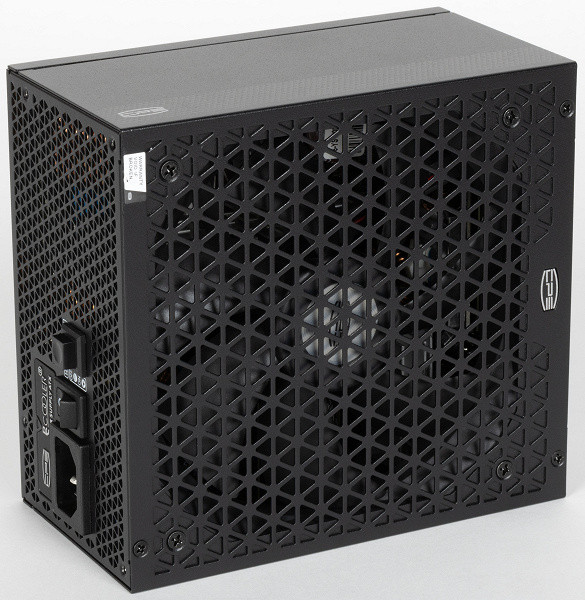
The design of the power supply looks attractive, although the use of a stamped grille over the fan can lead to increased noise levels during operation. However, stamped grilles are becoming increasingly popular, probably due to their ease of production and reduced cost of the power supply.
This power supply offers two cooling modes: hybrid, in which the fan may not work depending on the load power and temperature inside the unit, and active mode, where the fan runs constantly. Switching between modes is carried out using a two-position button located on the back of the power supply next to the power button.
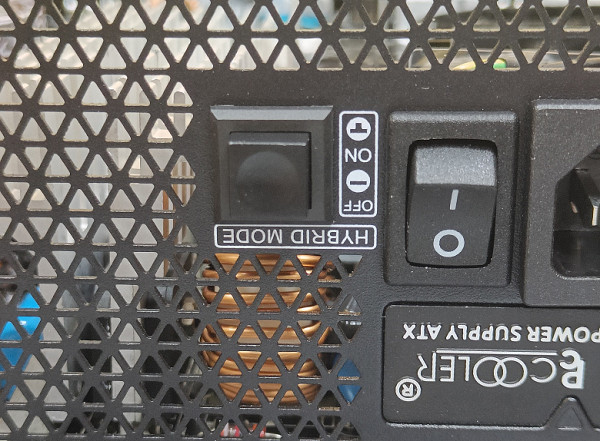
The power supply unit body is about 160 mm long. Please note that another 15-20 mm will be required to connect the wires, so it is recommended to provide about 180 mm during installation. For a power supply unit with such power, these dimensions can be considered quite compact.
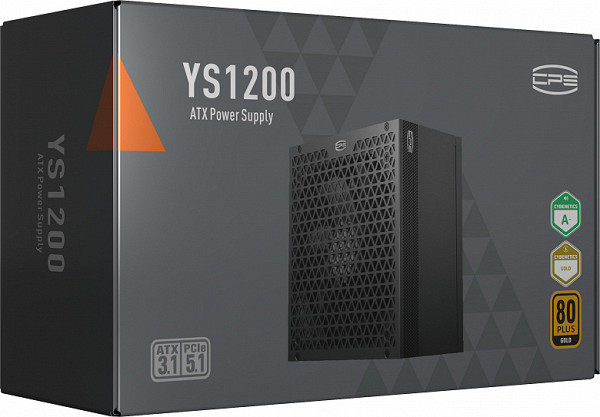
The power supply unit is supplied in a cardboard box with matte printing, which is made mainly in black and gray colors.
Characteristics
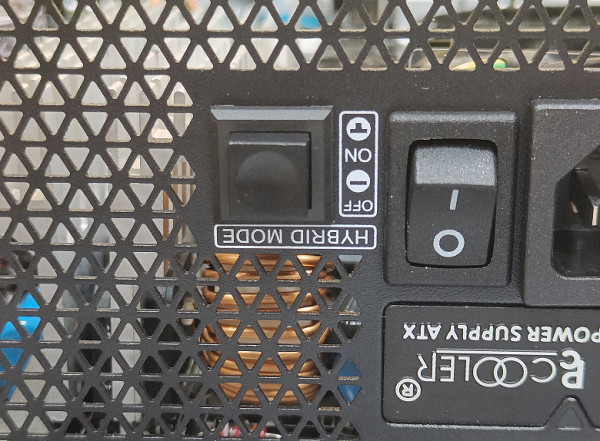
All necessary parameters are indicated on the power supply housing in full, the value of 1200 W is declared for the +12VDC bus power. The ratio of the power on the +12VDC bus to the total power is 100%, which is, of course, an excellent indicator.
Wires and connectors
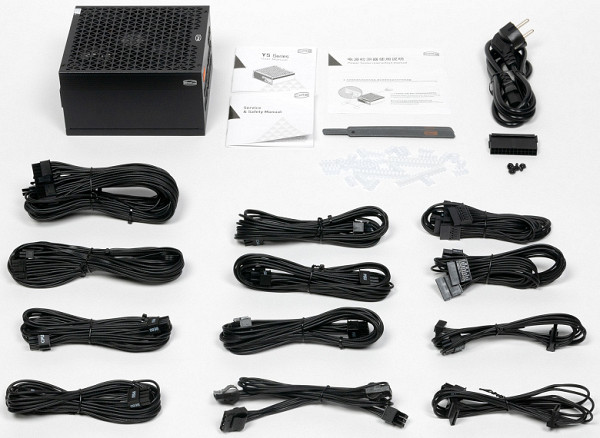
| Name of the connector | Number of connectors | Notes |
|---|---|---|
| 24 pin Main Power Connector | 1 | collapsible |
| 4 pin 12V Power Connector | — | |
| 8 pin SSI Processor Connector | 2 | collapsible |
| 6 pin PCIe 1.0 VGA Power Connector | — | |
| 8 pin PCIe 2.0 VGA Power Connector | 3 | on 3 cords |
| 16 pin PCIe 5.0 VGA Power Connector | 1 | |
| 4 pin Peripheral Connector | 3 | ergonomic, on one cord |
| 15 pin Serial ATA Connector | 12 | on 4 cords |
| 4 pin floppy drive connector | — |
Length of wires to power connectors
All wires without exception are modular, meaning they can be removed, leaving only those that are necessary for a specific system.
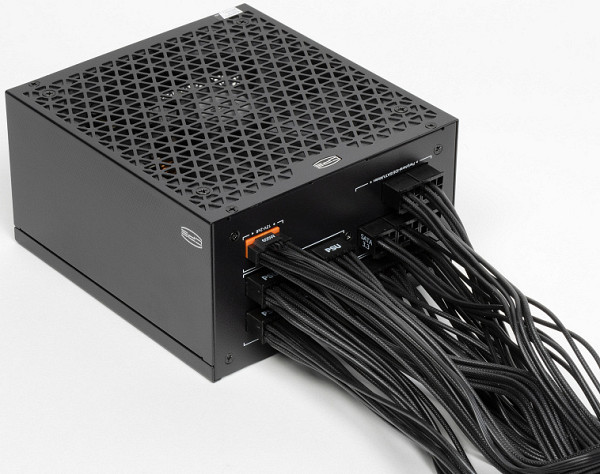
Here are the specifications of the power supply cables:
- 1 cable: to the main ATX connector — 61 cm.
- 2 cables: to the 8-pin SSI processor socket — 71 cm.
- 3 cables: to the PCIe 2.0 VGA Power Connector — 75 cm.
- 1 cable: to the PCIe 5.0 VGA Power Connector (12VHPWR) — 70 cm.
- 2 cables: to the first SATA Power Connector — 52 cm, plus 15 cm to the second, another 15 cm to the third, and another 15 cm to the fourth.
- 2 cables: to the first SATA Power Connector — 40 cm, plus 15 cm to the second.
- 1 cable: to the first Peripheral Connector («Molex») — 45 cm, plus 12 cm to the second, and another 15 cm to the third.
The cable length is sufficient for comfortable use in full tower and large cases with a top-mounted power supply. In cases up to 55 cm high with a bottom-mounted power supply, the cable length is also suitable, since the length to the processor power connectors exceeds 70 cm. Thus, the power supply is compatible with most modern cases.
The cables are covered with a rubber-like material, which ensures ease of assembly and manipulation. However, without lengthy tests, it is impossible to say how quickly dust will accumulate on such a coating.
The set of cables with SATA Power connectors deserves praise. The kit includes four cables: two with four connectors and two with two. Cables with four connectors have straight plugs, and cables with two have angled plugs. This allows you to simultaneously connect all four cables and an additional cable with peripheral connectors. For cases with one or two drives, short cables with a small number of SATA connectors are very convenient.
The cables are flexible and bend well, indicating a high copper content.
Circuitry and cooling
The power supply is equipped with an active power factor corrector and supports a wide range of input voltages from 100 to 240 volts. This ensures its stable operation even when the voltage in the electrical network drops below standard values.
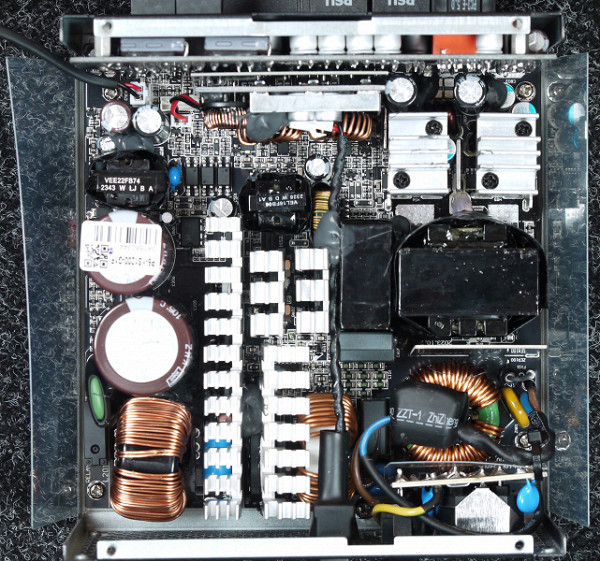
The design of the power supply unit complies with modern standards: it is equipped with an active power factor corrector, a synchronous rectifier for the +12VDC channel and independent pulse converters for the +3.3VDC and +5VDC lines.
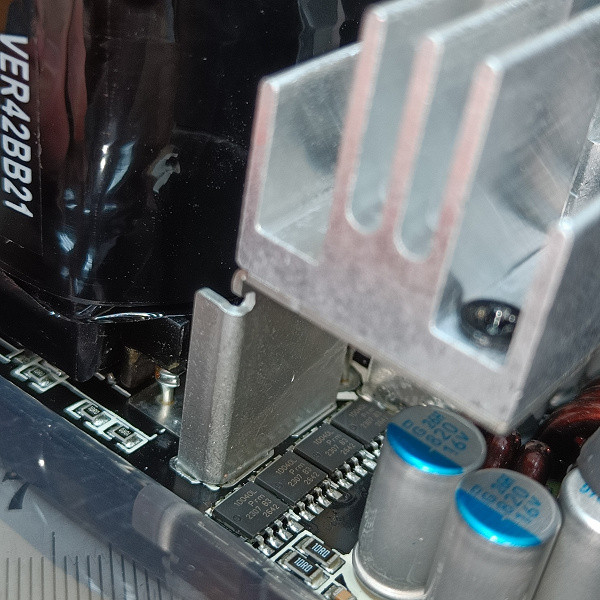
The semiconductor elements of the high-voltage circuits are placed on three radiators, where the input rectifier is also located. The elements of the synchronous rectifier are mounted on the front side of the main printed circuit board.
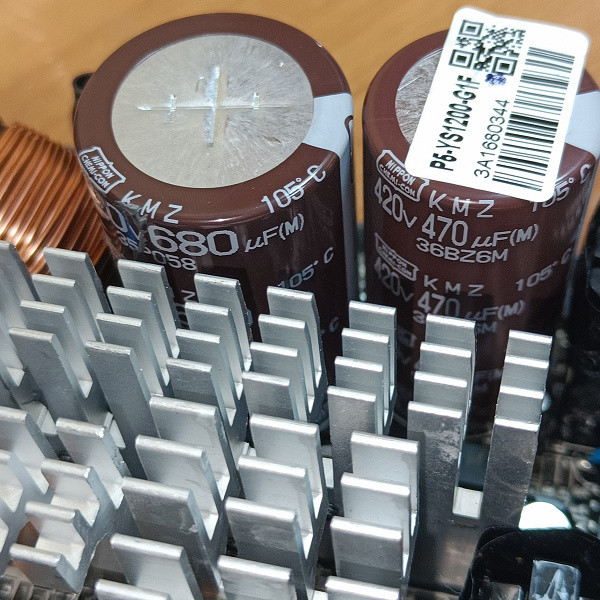
Independent +3.3VDC and 5VDC sources are mounted on a daughter PCB and have a small heat dissipator.
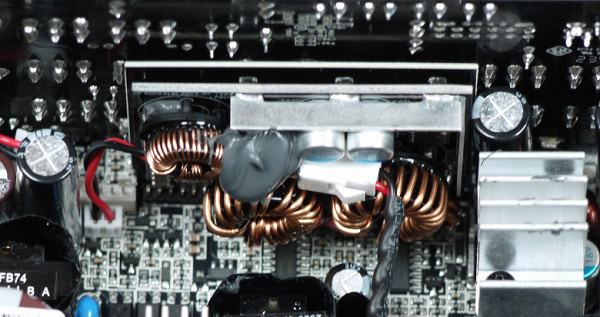
The device is equipped with electrolytic capacitors exclusively from Japanese brands Nippon Chemi-Con, Nichicon and Rubycon, as well as a large number of polymer capacitors.
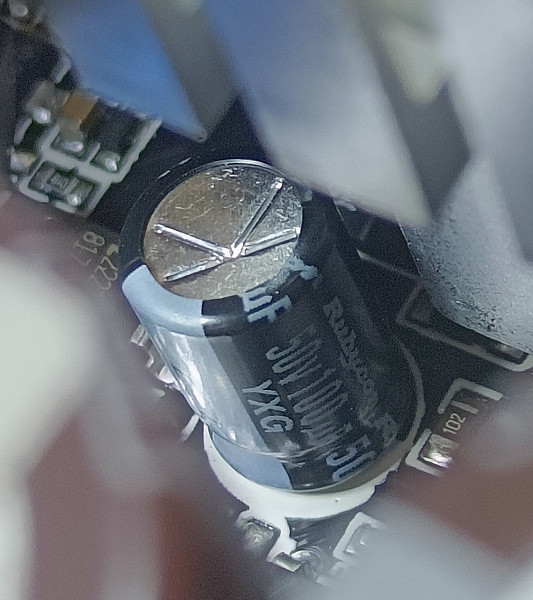
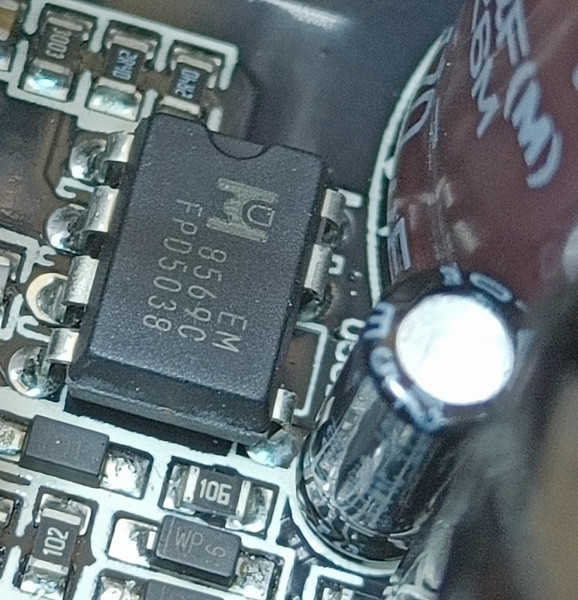
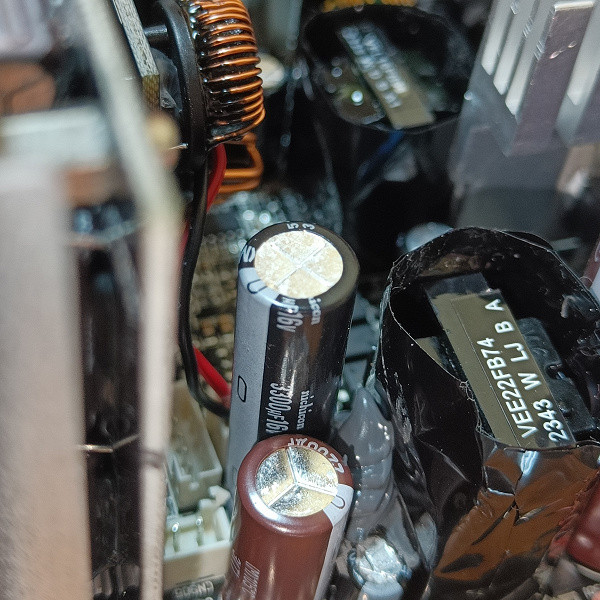
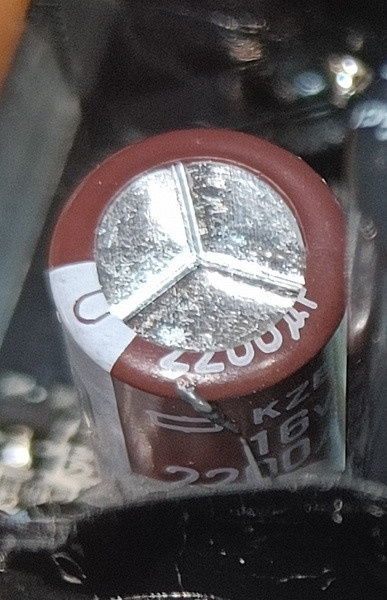
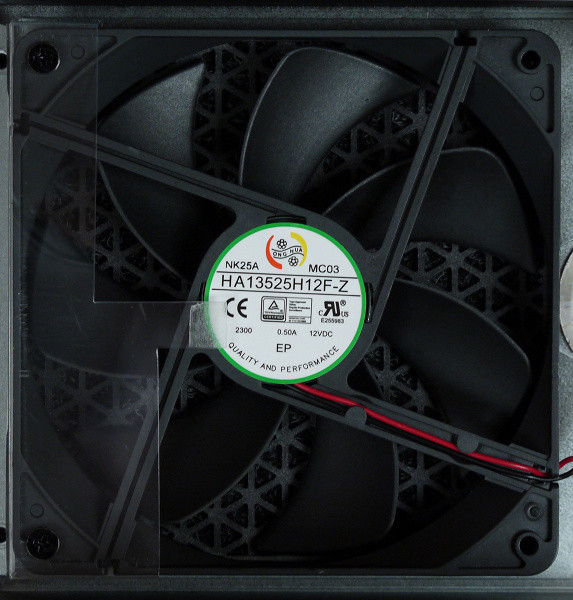
The power supply is equipped with a HA13525H12SF-Z fan (2300 rpm), which operates on a hydrodynamic bearing and is manufactured by Dongguan Honghua Electronic Technology. The fan has a four-wire plug connection, which indicates the presence of PWM speed control.
Measuring electrical characteristics
Now we proceed to instrumental testing of the electrical characteristics of the power supply using a multifunctional stand and specialized equipment.
Deviations of output voltages from nominal values are indicated by the following colors:
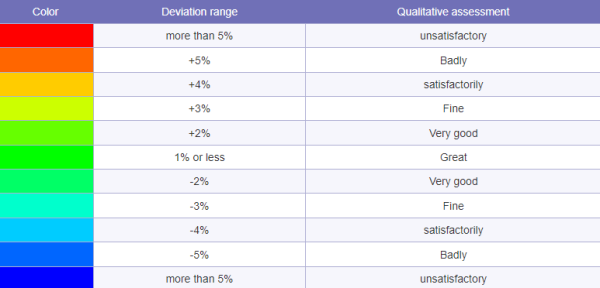
Working at maximum power
In the first stage of testing, the power supply operates at maximum power for a long time. This test allows you to confidently confirm the reliability and operability of the device.
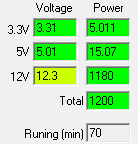
Cross-load characteristic
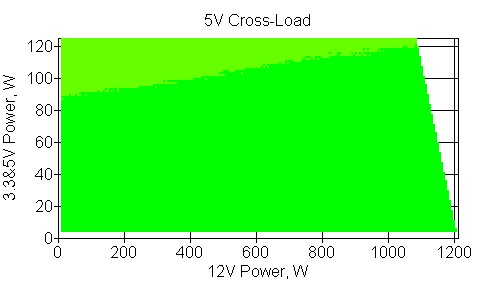
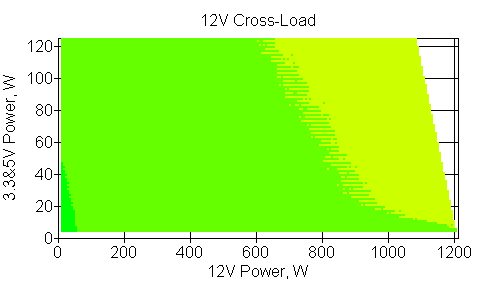
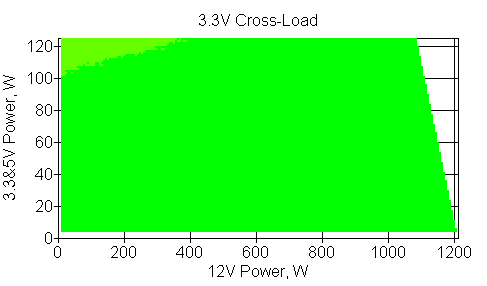
The cross-load characteristic (CLC) allows you to determine the permissible load level, especially on the +12VDC channel, for the tested power supply. In this case, voltage deviations on the +12VDC channel do not exceed 3% over the entire power range, which indicates high quality. With a typical power distribution across channels, deviations from the nominal values are no more than 1% on the +3.3VDC and +5VDC channels, and up to 3% on the +12VDC channel.
This power supply model is ideal for modern high-performance systems due to its high practical load capacity on the +12VDC channel.
Load capacity
The following test is designed to determine the maximum power that can be supplied through the connectors when the voltage deviation is no more than 3 or 5 percent from the nominal value.

In the case of a video card with a single power connector, the maximum power on the +12VDC channel is at least 150 W with a deviation of 3%.

For video cards with two power connectors and using two cables, the maximum power on the +12VDC channel reaches at least 350 W with a deviation of no more than 3%. This makes the power supply suitable for use with very powerful video cards.

When loaded through three PCIe 2.0 connectors, the maximum power on the +12VDC channel is at least 525 W with a deviation of 3%

A similar test was carried out at a power of 650 W, and it also did not reveal any significant deviations.

When loaded via the CPU power connector, the maximum power on the +12VDC channel reaches at least 250W with a deviation of no more than 3%. This provides enough power for typical systems with a single CPU power connector on the motherboard.

When loaded via the CPU power connector, the maximum power on the +12VDC channel reaches at least 250W with a deviation of no more than 3%. This provides enough power for typical systems with a single CPU power connector on the motherboard.

For the motherboard, the maximum power on the +12VDC channel is at least 150W with a deviation of 3%. Since the board itself consumes about 10W on this channel, the remaining power can be used to power expansion cards, such as video cards without additional power, which usually consume up to 75W. This indicates a high individual load capacity of the power supply.
Economy and efficiency
There are two main ways to evaluate the efficiency of a computer power supply. The first method involves evaluating the power supply as a separate energy converter, with an attempt to minimize the resistance of the transmission line from the power supply to the load (where the output current and voltage are measured). To do this, the power supply is connected using all available connectors, which creates unequal conditions for different models, since the set of connectors and the number of current-carrying wires may differ even for power supplies of the same power. Although such tests give correct results for each power supply separately, in real conditions power supplies are connected using a limited number of connectors. Therefore, it is more practical to determine the efficiency of the power supply not only at fixed power values, but also taking into account a fixed set of connectors for each load level. Traditionally, the efficiency of the power supply is expressed as a coefficient of performance (COP), which is the ratio of the output and input powers of the power supply. COP shows how efficiently the power supply converts electrical energy. For the average user, this parameter may not have any obvious meaning, except that higher efficiency implies better efficiency and quality of the PSU. Efficiency is also a popular marketing tool, especially in combination with the 80Plus certificate. However, from a practical point of view, efficiency does not affect system performance, noise level or temperature inside the system unit. It is primarily a technical parameter that depends on the development of technology and the cost of the product. For the user, increasing efficiency often means only an increase in the retail price.
On the other hand, to objectively assess the efficiency of a power supply, it is useful to consider the power loss during conversion and transmission of energy to end users. In this case, you can use absolute values, such as dissipated power (the difference between the input and output power) and energy consumption over a certain period (day, month, year) under constant load. This makes it easy to see the difference in power consumption between different PSU models and calculate the economic benefit of using more expensive power supplies.
Thus, we obtain a clear parameter — dissipated power, which can be converted into kilowatt-hours (kW h) for recording on an electric meter. By multiplying this value by the cost of a kilowatt-hour, we can estimate the electricity costs for round-the-clock operation of the system unit during the year. Although this is a hypothetical scenario, it helps to estimate the difference in operating costs between different power supplies and draw conclusions about the feasibility of purchasing them. In real conditions, the calculation may take a longer period — from 3 years or more. For the assessment, you can also adjust the value depending on the operating time of the system unit per day.
We plan to consider several typical options by power and correlate them with the number of connectors corresponding to these options in order to bring the efficiency measurement method as close as possible to the real operating conditions of the system unit. This will allow us to estimate the efficiency of different power supplies under identical conditions.
| Load via connectors | 12VDC, W | 5VDC, W | 3.3VDC, W | Total power, W |
|---|---|---|---|---|
| Main ATX, CPU (12V), SATA | 5 | 5 | 5 | 15 |
| Main ATX, CPU (12V), SATA | 80 | 15 | 5 | 100 |
| Main ATX, CPU (12V), SATA | 180 | 15 | 5 | 200 |
| Main ATX, CPU (12V), 6-pin PCIe, SATA | 380 | 15 | 5 | 400 |
| Main ATX, CPU (12V), 6-pin PCIe (1 cable with 2 connectors), SATA | 480 | 15 | 5 | 500 |
| Main ATX, CPU (12V), 6-pin PCIe (2 cables with 1 connector), SATA | 480 | 15 | 5 | 500 |
| Main ATX, CPU (12V), 6-pin PCIe (2 cables with 2 connectors), SATA | 730 | 15 | 5 | 750 |
The results obtained are as follows:
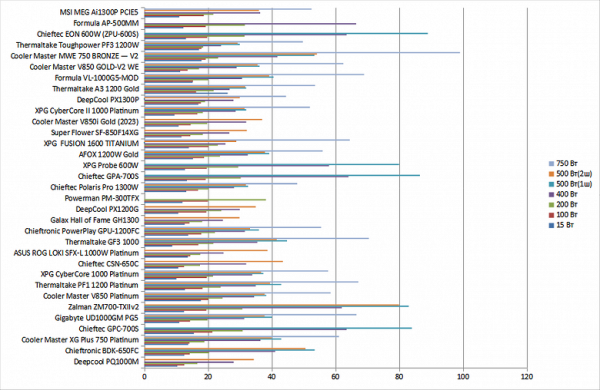
| Dissipated power, W | 15 W | 100 W | 200 W | 400 W | 500 W (1 cord) | 500W (2 cords) | 750 W |
|---|---|---|---|---|---|---|---|
| Cooler Master V1000 Platinum (2020) | 19.8 | 21.0 | 25.5 | 38.0 | 43.5 | 41.0 | 55.3 |
| Thermaltake TF1 1550 | 13.8 | 15.1 | 17.0 | 24.2 | 30.0 | 42.0 | |
| Thermaltake GF1 1000 | 15.2 | 18.1 | 21.5 | 31.5 | 38.0 | 37.3 | 65.0 |
| Chieftec PPS-1050FC | 10.8 | 13.0 | 17.4 | 29.1 | 35.1 | 34.6 | 58.0 |
| Deepcool PQ1000M | 10.4 | 12.6 | 16.7 | 28.1 | 34.4 | ||
| Gigabyte UD1000GM PG5 | 11.0 | 14.4 | 19.9 | 31.4 | 40.1 | 37.8 | 66.6 |
| Thermaltake PF1 1200 Platinum | 12.8 | 18.3 | 24.0 | 35.0 | 43.0 | 39.5 | 67.2 |
| XPG CyberCore 1000 Platinum | 10.1 | 19.6 | 21.6 | 33.9 | 37.4 | 36.7 | 57.7 |
| Asus ROG Loki SFX-L 1000W Platinum | 13.7 | 14.5 | 17.6 | 24.9 | 38.7 | ||
| Thermaltake GF3 1000 | 8.8 | 17.0 | 21.7 | 35.5 | 44.8 | 41.6 | 70.5 |
| Chieftronic PowerPlay GPU-1200FC | 13.8 | 17.9 | 22.2 | 31.6 | 36.0 | 33.2 | 55.5 |
| Galax Hall of Fame GH1300 | 12.7 | 14.2 | 18.2 | 24.7 | 29.9 | ||
| Deepcool PX1200G | 10.7 | 19.5 | 24.2 | 30.0 | 35.0 | ||
| Chieftec Polaris Pro 1300W | 13.2 | 16.9 | 20.3 | 28.2 | 32.6 | 31.9 | 48.0 |
| Afox 1200W Gold | 15.3 | 18.8 | 23.8 | 32.5 | 39.2 | 37.9 | 56.0 |
| XPG Fusion 1600 Titanium | 14.0 | 20.2 | 23.1 | 25.5 | 28.9 | 64.5 | |
| XPG CyberCore II 1000 Platinum | 9.5 | 16.7 | 18.4 | 28.7 | 32.0 | 31.5 | 52.0 |
| DeepCool PX1300P | 17.0 | 17.8 | 19.1 | 28.0 | 30.0 | 44.5 | |
| Thermaltake GF A3 Gold 1200W | 26.2 | 16.3 | 21.8 | 26.8 | 32.0 | 31.7 | 53.6 |
| Formula VL-1000G5-MOD | 15.2 | 15.3 | 20.1 | 30.7 | 40.6 | 39.2 | 69.0 |
| Thermaltake Toughpower PF3 1200W | 17.2 | 18.0 | 18.5 | 24.1 | 30.0 | 29.3 | 49.8 |
| PCCooler YS1200 | 10.4 | 18.0 | 22.0 | 27.5 | 33.1 |
This model has relatively high efficiency in all tested modes, it is not an outstanding, but not a failure representative of power sources with a capacity of more than a kilowatt. For models with the 80Plus Gold certification level, such efficiency can be called typical.
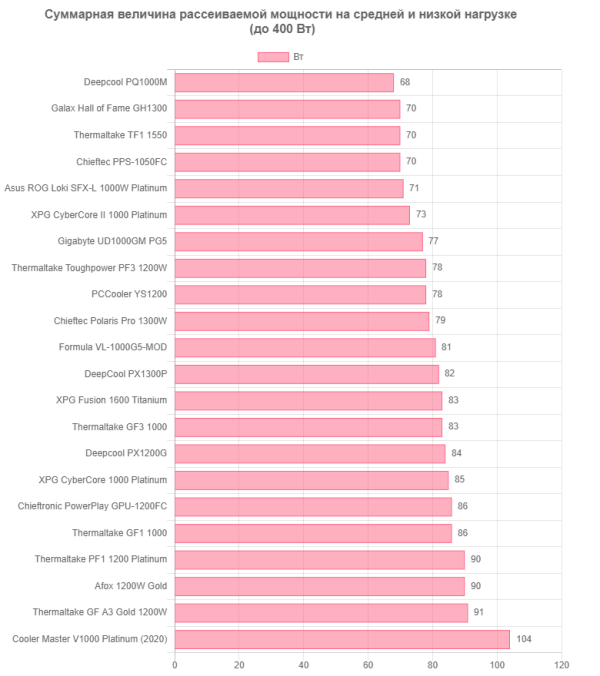
In low-load modes, this model occupies approximately the middle position among its classmates, but its capabilities are truly revealed under high load.
| Energy consumption of a computer per year, kW h | 15 W | 100 W | 200 W | 400 W | 500 W (1 cord) | 500W (2 cords) | 750 W |
|---|---|---|---|---|---|---|---|
| Cooler Master V1000 Platinum (2020) | 305 | 1060 | 1975 | 3837 | 4761 | 4739 | 7054 |
| Thermaltake TF1 1550 | 252 | 1008 | 1901 | 3716 | 4643 | 6938 | |
| Thermaltake GF1 1000 | 265 | 1035 | 1940 | 3780 | 4713 | 4707 | 7139 |
| Chieftec PPS-1050FC | 226 | 990 | 1904 | 3759 | 4688 | 4683 | 7078 |
| Deepcool PQ1000M | 223 | 986 | 1898 | 3750 | 4681 | ||
| Gigabyte UD1000GM PG5 | 228 | 1002 | 1926 | 3779 | 4731 | 4711 | 7153 |
| Thermaltake PF1 1200 Platinum | 244 | 1036 | 1962 | 3811 | 4757 | 4726 | 7159 |
| XPG CyberCore 1000 Platinum | 220 | 1048 | 1941 | 3801 | 4708 | 4702 | 7076 |
| Asus ROG Loki SFX-L 1000W Platinum | 251 | 1003 | 1906 | 3722 | 4719 | ||
| Thermaltake GF3 1000 | 209 | 1025 | 1942 | 3815 | 4772 | 4744 | 7188 |
| Chieftronic PowerPlay GPU-1200FC | 252 | 1033 | 1947 | 3781 | 4695 | 4671 | 7056 |
| Galax Hall of Fame GH1300 | 243 | 1000 | 1911 | 3720 | 4642 | ||
| Deepcool PX1200G | 225 | 1047 | 1964 | 3767 | 4687 | ||
| Chieftec Polaris Pro 1300W | 247 | 1024 | 1930 | 3751 | 4666 | 4659 | 6991 |
| Afox 1200W Gold | 265 | 1041 | 1961 | 3789 | 4723 | 4712 | 7061 |
| XPG Fusion 1600 Titanium | 254 | 1053 | 1954 | 3727 | 4633 | 7135 | |
| XPG CyberCore II 1000 Platinum | 215 | 1022 | 1913 | 3755 | 4660 | 4656 | 7026 |
| DeepCool PX1300P | 280 | 1032 | 1919 | 3749 | 4643 | 6960 | |
| Thermaltake GF A3 Gold 1200W | 361 | 1019 | 1943 | 3739 | 4660 | 4658 | 7040 |
| Formula VL-1000G5-MOD | 265 | 1010 | 1928 | 3773 | 4736 | 4723 | 7174 |
| Thermaltake Toughpower PF3 1200W | 282 | 1034 | 1914 | 3715 | 4643 | 4637 | 7006 |
| PCCooler YS1200 | 223 | 1034 | 1945 | 3745 | 4670 |
In this case, we also present measurements of traditional efficiency . The results were recorded with a constant load on the +3.3VDC (5 W) and +5VDC (15 W) channels and variable power on the +12VDC channel.
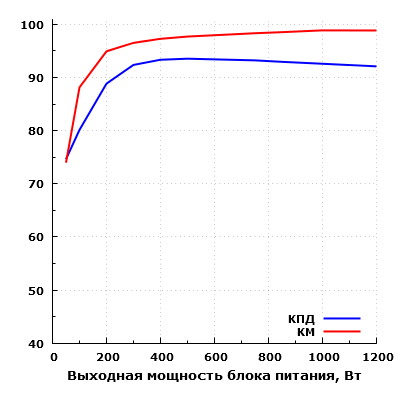
During the testing of the power supply, we measured its parameters at 10 different points. The results showed that the maximum efficiency was 93.5% at an output power of 500 W. At a load of 1200 W, the maximum dissipated power reached 103 W, which is quite low for a power supply of this power.
Hybrid cooling mode
The PCCooler power supply has a hybrid cooling mode, which is activated by a button on the back of the device.
In this mode, the fan turns on when the output power reaches about 370 watts. There is probably also a temperature limit for turning on the fan, but under typical conditions it was not reached. The fan turns off at a power of less than 370 watts and a temperature inside the power supply below 74 degrees. When working at a power of 350 watts for two hours, the temperature did not exceed 71 degrees, so the fan did not turn on. The power supply showed stable operation without turning on the fan at a power of 200 watts and below, when the fan quickly stops and does not turn on even after a significant load.
It is important to take into account that when working with the fan off, the temperature of the internal components of the power supply strongly depends on the ambient air temperature. If it reaches 40-45 ° C, this may lead to an earlier activation of the fan.
Temperature conditions
The thermal load of the capacitors when operating with a constantly rotating fan at a power of over 850 W is quite high (exceeds 75 degrees), but it can be considered satisfactory.
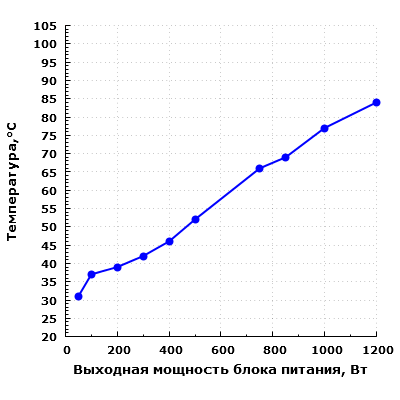
In hybrid cooling mode, the power supply temperature reached 71 degrees at a load of 350 W and 65 degrees at a load of 200 W, which is quite suitable for long-term operation.
However, it should be noted that operation in hybrid mode can significantly reduce the service life of capacitors.
Acoustic ergonomics
To measure the noise level of power supplies, we used the following method. The power supply was placed on a flat surface with the fan facing up, and the measuring microphone of the Oktava 110A-Eco noise meter was located at a distance of 0.35 meters above it. The power supply was loaded using a special stand in silent mode. During testing, the power supply operated at constant power for 20 minutes, after which the noise level was measured.
This distance to the measurement object is close to the conditions of desktop placement of a system unit with an installed power supply. This method allows you to estimate the noise level of the power supply in conditions where the distance from the noise source to the user is minimal. With an increase in the distance and the presence of additional sound-reflecting barriers, the noise level at the control point will decrease, which will improve acoustic ergonomics.
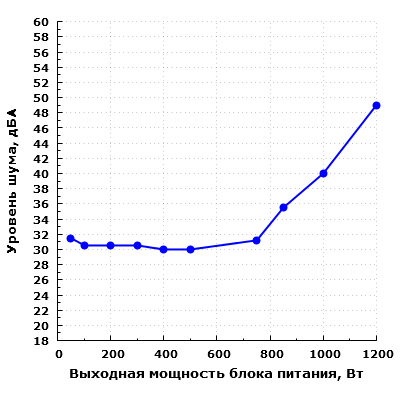
When operating a power supply with a constantly rotating fan in the power range from 50 to 750 W, the noise level is at an acceptable level for a residential area during the day.
At a power of 850 W, the noise approaches the average values for the near field. At a greater distance from the power supply, for example, under a table or in a case with a bottom-mounted power supply, this noise can be assessed as below average. During the day, in a residential area, a source with such a noise level will be barely noticeable from a distance of a meter or more, and even less noticeable in an office, where background noise is usually higher. At night, the level of such noise will be clearly audible, which can make it difficult to sleep nearby. However, when working at a computer, the noise level is considered comfortable.
With an increase in output power, the noise level increases noticeably. At a power of 1000 W, the noise level reaches 40 dBA, which is a high level for a residential area during the day. At 1200 W, the noise becomes very high and is about 49 dBA, which is not applicable even for office conditions.
In terms of acoustic ergonomics, this power supply model provides comfort with an output power of up to 850 W.
The noise level of the power supply electronics was also assessed, since in some cases it can create unwanted sounds. For this, the difference in noise levels in the laboratory with the power supply on and off was measured. If the difference is less than 5 dBA, there are no deviations in acoustic properties. A difference of more than 10 dBA may indicate defects that are audible from a distance of less than half a meter. Measurements were taken at a distance of about 40 mm from the upper surface of the power supply, since at greater distances, measuring electronic noise becomes difficult.
| Power, W | Noise level from the grille side, dBA | Deviation from background level, dBA |
|---|---|---|
| 15 | 26 | +6 |
| 50 | 24 | +4 |
| 100 | 25 | +5 |
| 200 | 23 | +3 |
| 300 | 23 | +3 |
The noise of the electronics is minimal, it will be impossible to hear it even from a minimum distance, not to mention the case of an assembled system.
Consumer qualities
The consumer qualities of the PCCooler YS1200 power supply demonstrate good results. Its high load capacity on the +12VDC channel allows it to be used in powerful systems with several video cards. Although the acoustic ergonomics at maximum power leaves much to be desired, at low and medium loads up to 850 W the noise level remains acceptable. At the same time, components consuming more than 850 W will themselves create significant noise. The hybrid cooling mode allows the power supply to operate without turning on the fan at a power of up to 200 W, and the fan turns on at a load of more than 350 W or in comfortable temperature conditions.
The length of the wires is sufficient for most modern cases, they are soft, with a pleasant shell and completely removable, which simplifies assembly and operation. It is also worth noting the presence of a large number of cords with SATA Power connectors.
In addition, the power supply supports connecting video cards via a PCIe 5.0 power connector.
Results
The PCCooler YS1200 is a reliable, high-power power supply unit, priced from $260 at the time of this review. Its specifications are very good, thanks to the high load capacity of the +12VDC channel, excellent efficiency, a high-quality fan with a fluid-dynamic bearing, and Japanese capacitors. This model is expected to have a long service life even under high loads and active use. The power supply can also operate for a long time with the fan stopped at a power of up to 200 W.
